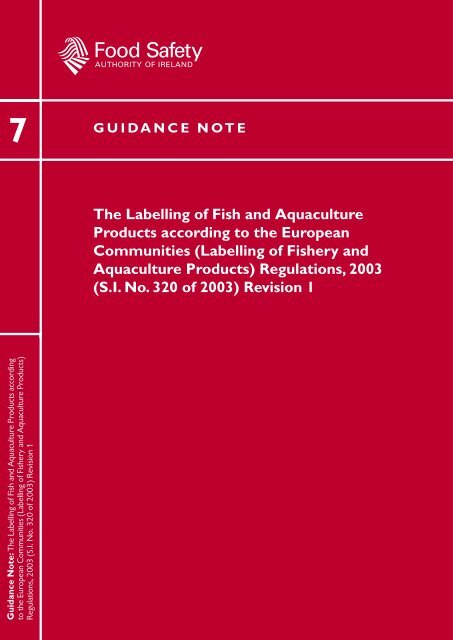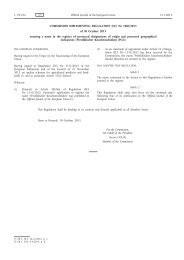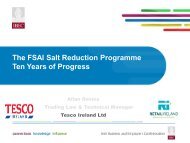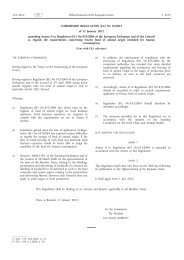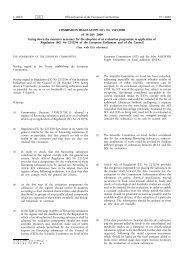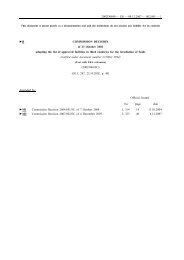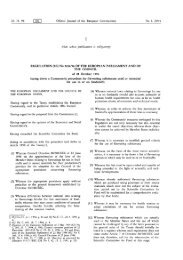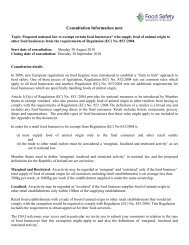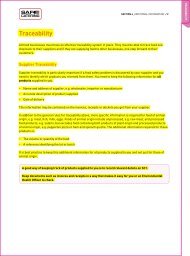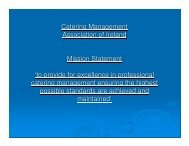Guidance Note No. 7 - The Food Safety Authority of Ireland
Guidance Note No. 7 - The Food Safety Authority of Ireland
Guidance Note No. 7 - The Food Safety Authority of Ireland
Create successful ePaper yourself
Turn your PDF publications into a flip-book with our unique Google optimized e-Paper software.
7<br />
<strong>Guidance</strong> <strong><strong>No</strong>te</strong>: <strong>The</strong> Labelling <strong>of</strong> Fish and Aquaculture Products according<br />
to the European Communities (Labelling <strong>of</strong> Fishery and Aquaculture Products)<br />
Regulations, 2003 (S.I. <strong>No</strong>. 320 <strong>of</strong> 2003) Revision 1<br />
G U I DA N C E N OT E<br />
<strong>The</strong> Labelling <strong>of</strong> Fish and Aquaculture<br />
Products according to the European<br />
Communities (Labelling <strong>of</strong> Fishery and<br />
Aquaculture Products) Regulations, 2003<br />
(S.I. <strong>No</strong>. 320 <strong>of</strong> 2003) Revision 1
<strong>Guidance</strong> <strong><strong>No</strong>te</strong> <strong>No</strong>. 7<br />
<strong>The</strong> Labelling <strong>of</strong> Fish and Aquaculture<br />
Products according to the European Communities<br />
(Labelling <strong>of</strong> Fishery and Aquaculture Products)<br />
Regulations, 2003 (S.I. <strong>No</strong>. 320 <strong>of</strong> 2003) Revision 1<br />
Published by:<br />
<strong>Food</strong> <strong>Safety</strong> <strong>Authority</strong> <strong>of</strong> <strong>Ireland</strong><br />
Abbey Court<br />
Lower Abbey Street<br />
Dublin 1<br />
Tel: +353 1 817 1300 Fax: +353 1 817 1301<br />
Email: info@fsai.ie Website: www.fsai.ie<br />
©2005<br />
Applications for reproduction should be made to the FSAI Information Unit<br />
ISBN 1-904465-26-9
Other food safety <strong>Guidance</strong> <strong><strong>No</strong>te</strong>s available from the <strong>Food</strong><br />
<strong>Safety</strong> <strong>Authority</strong> <strong>of</strong> <strong>Ireland</strong>:<br />
<strong>Guidance</strong> <strong><strong>No</strong>te</strong> <strong>No</strong>.1 Inspection <strong>of</strong> a <strong>Food</strong> Business (2000)<br />
ISBN 0-9539183-2-7<br />
<strong>Guidance</strong> <strong><strong>No</strong>te</strong> <strong>No</strong>.2 EU Classification <strong>of</strong> <strong>Food</strong> (2001)<br />
ISBN 0-9539183-3-5<br />
<strong>Guidance</strong> <strong><strong>No</strong>te</strong> <strong>No</strong>.3 Interpretation <strong>of</strong> Results <strong>of</strong> Microbiological Analysis <strong>of</strong> Some<br />
Ready-to-Eat <strong>Food</strong>s Sampled at Point <strong>of</strong> Sale (2001)<br />
ISBN 0-9539183-5-1<br />
<strong>Guidance</strong> <strong><strong>No</strong>te</strong> <strong>No</strong>.4 Approval and Operation <strong>of</strong> Independent Meat Production Units<br />
under EC Meat Legislation. Meat Products, Minced Meat & Meat<br />
Preparations (2001)<br />
ISBN 0-9539183-6-X<br />
<strong>Guidance</strong> <strong><strong>No</strong>te</strong> <strong>No</strong>.5 Approval and Operation <strong>of</strong> Independent<br />
Meat Production Units under EC Fresh Meat<br />
Legislation (2001)<br />
ISBN 0-9539183-7-8<br />
<strong>Guidance</strong> <strong><strong>No</strong>te</strong> <strong>No</strong>.6 Implementation <strong>of</strong> European Communities (Infant Formulae and<br />
Follow-on Formulae) Regulations, 1998 to 2002 (2001)<br />
ISBN 0-9539183-9-4<br />
<strong>Guidance</strong> <strong><strong>No</strong>te</strong> <strong>No</strong>.7 <strong>The</strong> Labelling <strong>of</strong> Fish and Aquaculture Products according to<br />
Council Regulation (EC) <strong>No</strong>. 104/2000 and Commission<br />
Regulation (EC) <strong>No</strong>. 2065/2001 (2002)<br />
ISBN 0-9540754-5-5<br />
<strong>Guidance</strong> <strong><strong>No</strong>te</strong> <strong>No</strong>.8 <strong>The</strong> Implementation <strong>of</strong> <strong>Food</strong> <strong>Safety</strong> Management Systems in Beef<br />
and Lamb Slaughter Plants based on HACCP Principles (2002)<br />
ISBN 0-9540754-6-3<br />
<strong>Guidance</strong> <strong><strong>No</strong>te</strong> <strong>No</strong>.9 Flavourings Legislation (2002)<br />
ISBN 0-9540754-2-0<br />
<strong>Guidance</strong> <strong><strong>No</strong>te</strong> <strong>No</strong>.10 Product Recall and Traceability (2002)<br />
ISBN 0-9540754-9-8
<strong>Guidance</strong> <strong><strong>No</strong>te</strong> <strong>No</strong>.11 Compliance with Regulation 4.2 <strong>of</strong> the European<br />
Communities (Hygiene <strong>of</strong> <strong>Food</strong>stuffs) Regulations 2000 (S.I. <strong>No</strong>.<br />
165 <strong>of</strong> 2000) (2002)<br />
ISBN 1-904465-17-X<br />
<strong>Guidance</strong> <strong><strong>No</strong>te</strong> <strong>No</strong>. 12 <strong>The</strong> Inspection <strong>of</strong> <strong>Food</strong> <strong>Safety</strong> Training and<br />
Competence (2003)<br />
ISBN 1-904465-07-2<br />
<strong>Guidance</strong> <strong><strong>No</strong>te</strong> <strong>No</strong>. 13 Use <strong>of</strong> Enforcement Powers Under the <strong>Food</strong> <strong>Safety</strong><br />
<strong>Authority</strong> <strong>of</strong> <strong>Ireland</strong> Act, 1998 (2003)<br />
ISBN 1-904465-05-6<br />
<strong>Guidance</strong> <strong><strong>No</strong>te</strong> <strong>No</strong>.14 <strong>The</strong> Application <strong>of</strong> Commission Directive 2001/101/EC as<br />
Amended by Commission Directive 2002/86/EC on the<br />
Definition <strong>of</strong> Meat (2003)<br />
ISBN 1-904465-09-9<br />
<strong>Guidance</strong> <strong><strong>No</strong>te</strong> <strong>No</strong>. 15 Cook-Chill Systems in the <strong>Food</strong> Service Sector (2004)<br />
ISBN 1-904465-19-6
Contents Page<br />
BACKGROUND 1<br />
DISCLAIMER 2<br />
SCOPE OF GUIDANCE NOTE 3<br />
1. INTRODUCTION 3<br />
2. SCOPE OF THE REGULATIONS 4<br />
3. RETAIL SALE 4<br />
4. FISH 4<br />
5. FINAL CONSUMER 5<br />
6. CONSUMER INFORMATION 5<br />
7. POINT OF SALE 7<br />
8. LABELS 8<br />
9. NOTES FOR PRODUCERS AND WHOLESALERS 8<br />
10. ENFORCEMENT 9<br />
FURTHER INFORMATION 10
BACKGROUND<br />
<strong>The</strong> <strong>Food</strong> <strong>Safety</strong> <strong>Authority</strong> <strong>of</strong> <strong>Ireland</strong> Act, 1998 established the <strong>Food</strong> <strong>Safety</strong> <strong>Authority</strong> <strong>of</strong> <strong>Ireland</strong> (FSAI)<br />
to perform the functions assigned to it by the Act.<br />
<strong>The</strong> principal function <strong>of</strong> the <strong>Authority</strong> is to take all reasonable steps to ensure that:<br />
(a) food produced in the State (whether or not distributed or marketed in the State), and<br />
(b) food distributed or marketed in the State, meets the highest standards <strong>of</strong> food safety and<br />
hygiene reasonably attainable.<br />
<strong>The</strong> FSAI is required, in particular, to take all reasonable steps to ensure that such food complies:<br />
1) with any relevant food legislation in respect <strong>of</strong> food safety and hygiene standards, or<br />
2) in the absence <strong>of</strong> any such legislation, with the provisions <strong>of</strong> generally recognised standards or<br />
codes <strong>of</strong> good practice aimed at ensuring the achievement <strong>of</strong> high standards <strong>of</strong> food hygiene<br />
and food safety.<br />
<strong>The</strong> FSAI believes that <strong>Guidance</strong> <strong><strong>No</strong>te</strong>s have a major role to play in helping both the regulators and the<br />
food industry to achieve a higher degree <strong>of</strong> compliance with the Regulations and with good practice<br />
generally. A good, well prepared <strong>Guidance</strong> <strong><strong>No</strong>te</strong> must, if it is to achieve these objectives, provide<br />
regulators and industry alike with clear guidance towards the application <strong>of</strong> the relevant legislation.<br />
While a <strong>Guidance</strong> <strong><strong>No</strong>te</strong> is not a substitute for the Regulations, the FSAI believes that adherence to it<br />
should make compliance easier, by providing the basis for a high degree <strong>of</strong> consistency in the application<br />
<strong>of</strong> those Regulations.<br />
Due to the widening variety <strong>of</strong> supply, particularly <strong>of</strong> fresh and chilled fishery products, it is essential<br />
to provide consumers with a minimum amount <strong>of</strong> information on the main characteristics <strong>of</strong> the<br />
products.<br />
This publication is a guide to the labelling <strong>of</strong> fishery and aquaculture products as required by the European<br />
Communities (Labelling <strong>of</strong> Fishery and Aquaculture Products) Regulations, 2003 (S.I. <strong>No</strong>. 320 <strong>of</strong> 2003)<br />
which transposes:<br />
• Council Regulation (EC) <strong>No</strong>. 104/2000 on the common organisation <strong>of</strong> the markets in<br />
fishery and aquaculture products and<br />
• Commission Regulation (EC) <strong>No</strong>. 2065/2001 laying down detailed rules for the<br />
application <strong>of</strong> Council Regulation (EC) <strong>No</strong>. 104/2000 as regards informing consumers<br />
about fishery and aquaculture products.<br />
1
This <strong>Guidance</strong> <strong><strong>No</strong>te</strong> has been prepared in consultation with the Department <strong>of</strong> Communications, Marine<br />
and Natural Resources (DCMNR) and Bord Iascaigh Mhara (BIM).<br />
DCMNR is responsible for transposing this European legislation, while BIM holds the remit for the<br />
sustainable development <strong>of</strong> the Irish seafood industry.<br />
<strong>The</strong> FSAI has the overall responsibility for the enforcement <strong>of</strong> the European and national legislation in<br />
collaboration with the <strong>of</strong>ficial agencies that work under service contract to the FSAI according to the<br />
FSAI Act, 1998.<br />
DISCLAIMER<br />
This document is intended to act as a guideline to the European Communities (Labelling <strong>of</strong> Fishery<br />
and Aquaculture Products) Regulations, 2003 (S.I. <strong>No</strong>. 320 <strong>of</strong> 2003). It does not purport to be<br />
comprehensive or to be a legal interpretation or to constitute legal or other pr<strong>of</strong>essional advice.<br />
Changes to the legislation can be expected in the future that will necessitate this <strong>Guidance</strong> <strong><strong>No</strong>te</strong> being<br />
further updated.<br />
This <strong>Guidance</strong> <strong><strong>No</strong>te</strong> should be read in conjunction with:<br />
• European Communities (Labelling <strong>of</strong> Fishery and Aquaculture Products) Regulations, 2003<br />
(S.I. <strong>No</strong>. 320 <strong>of</strong> 2003)<br />
• European Communities (Labelling, Presentation and Advertising <strong>of</strong> <strong>Food</strong>stuffs) Regulations,<br />
2002 (S.I. <strong>No</strong>. 483 <strong>of</strong> 2002)<br />
• European Communities (Fishery Products) (Health Conditions and Hygiene Rules for Production<br />
and Placing on the Market) Regulations, 1996 (S.I. <strong>No</strong>. 170 <strong>of</strong> 1996)<br />
• European Communities (Live Bivalve Molluscs) (Health Conditions for Production and Placing<br />
on the Market) Regulations, 1996 (S.I. <strong>No</strong>. 147 <strong>of</strong> 1996)<br />
• <strong>Food</strong> <strong>Safety</strong> <strong>Authority</strong> <strong>of</strong> <strong>Ireland</strong> - <strong>Guidance</strong> <strong><strong>No</strong>te</strong> <strong>No</strong>.10 – Product Recall and Traceability<br />
• <strong>Food</strong> <strong>Safety</strong> <strong>Authority</strong> <strong>of</strong> <strong>Ireland</strong> - <strong>The</strong> Labelling <strong>of</strong> <strong>Food</strong> in <strong>Ireland</strong> 2002<br />
Examples contained in this <strong>Guidance</strong> <strong><strong>No</strong>te</strong> are not exhaustive and are intended for illustration only.<br />
2
SCOPE OF THIS GUIDANCE NOTE<br />
It is the aim <strong>of</strong> this document to give guidance on the European Communities (Labelling <strong>of</strong> Fishery and<br />
Aquaculture Products) Regulations, 2003 (S.I. <strong>No</strong>. 320 <strong>of</strong> 2003).<br />
Specifically, it details the labelling and packaging requirements for fishery and aquaculture products and<br />
the traceability <strong>of</strong> such products as specified in these particular Regulations. Other Regulations may also<br />
apply, and care should be taken to ensure that fishery and aquaculture products meet the requirements<br />
<strong>of</strong> all relevant legislation. Further information can be obtained from the FSAI’s “<strong>The</strong> Labelling <strong>of</strong> <strong>Food</strong><br />
in <strong>Ireland</strong> 2002”<br />
<strong>The</strong> Regulations to which this guideline relates specifies a minimum amount <strong>of</strong> information that must be<br />
provided on the label where fishery products are sold at retail level to consumers.<br />
In addition, for the purposes <strong>of</strong> traceability this information must be included on the commercial<br />
documents for the fishery products throughout the marketing chain, such as during processing, at<br />
wholesale level and for use by caterers.<br />
1. INTRODUCTION<br />
<strong>The</strong> objectives <strong>of</strong> the European Communities (Labelling <strong>of</strong> Fishery and Aquaculture Products)<br />
Regulations, 2003 (S.I. <strong>No</strong>. 320 <strong>of</strong> 2003) (“the Regulations”) are to revise the organisation <strong>of</strong> the<br />
market in fishery products to take account <strong>of</strong> market developments, changes in recent years in fishing<br />
activities, the increased volume <strong>of</strong> gourmet fish on the market and the shortcomings detected in the<br />
implementation <strong>of</strong> the rules previously in force.<br />
This <strong>Guidance</strong> <strong><strong>No</strong>te</strong> also provides advice on best practice (highlighted in bold and italics), which is<br />
considered above what is required to comply with the Regulations.<br />
3
2. SCOPE OF THE REGULATIONS<br />
<strong>The</strong> Regulations deal with the retail sale <strong>of</strong> fish to the final consumer and the consumer information that<br />
must be supplied at that point <strong>of</strong> sale.<br />
3. RETAIL SALE<br />
“Retail sale” is sale from a fishmonger, shop, or supermarket, or other characteristically similar sale.<br />
Catering sales (e.g. from a restaurant, “fish & chip shop” or other takeaway) are not covered by the<br />
Regulations.<br />
4. FISH<br />
“Fish” means raw fish to which no other ingredients (including additives, colourings, flavourings)<br />
except salt have been added and includes:<br />
• live fish<br />
• fresh, chilled and frozen fish<br />
• fish fillets and other fish meat (whether minced or not)<br />
• dried, salted or brined fish<br />
• smoked fish (whether hot or cold smoked fish)<br />
• crustaceans (except those which are both cooked and peeled)<br />
• molluscs (except when cooked).<br />
Fish that has been further processed (beyond simple slicing or mincing), preserved, treated or cooked<br />
are not covered by the Regulations. e.g. tinned or canned sardines, salmon or tuna, pickled herrings,<br />
and cooked mussels would all be outside the scope <strong>of</strong> the Regulations.<br />
Similarly, products containing fish and other ingredients are not covered by the Regulations. Examples<br />
would include sandwiches and sandwich fillings, fish fingers, battered fish fillets, prawns coated in<br />
breadcrumbs, seafood chowders, fish pies, prawn cocktail and sauces containing fish or fish stock.<br />
Smoked fish is covered by the Regulations except where ingredients other than those from the smoking<br />
process and salts are added, e.g. sugar, pepper or dill.<br />
4
NOTE: Where these Regulations do not apply the general or specific labelling provisions in other<br />
legislation may still apply.<br />
Small quantities <strong>of</strong> fish (that is less than ¤20 in value) sold to the final consumer by a fisherman or a<br />
fish farmer are also exempt from the Regulations.<br />
5. FINAL CONSUMER<br />
A “final consumer” may be considered to be anyone who is not buying the fish in the course <strong>of</strong> a trade<br />
or business.<br />
6. CONSUMER INFORMATION<br />
<strong>The</strong>re are 3 important pieces <strong>of</strong> “consumer information” to be provided at the point <strong>of</strong> sale:<br />
• <strong>The</strong> commercial designation <strong>of</strong> the species <strong>of</strong> fish<br />
• <strong>The</strong> method <strong>of</strong> production<br />
• <strong>The</strong> origin.<br />
<strong>The</strong> commercial designation is the name associated with the particular species <strong>of</strong> fish, e.g. the<br />
commercial designation for Gadus morhua is Cod. <strong>The</strong> full list <strong>of</strong> commercial designations can be found<br />
in the schedule attached to the Regulations or on the FSAI’s website – www.fsai.ie.<br />
A commercial designation not appearing in the Irish Regulations may, however, still be used if it appears<br />
in a list <strong>of</strong> commercial designations laid down by another EU Member State in the same language as the<br />
Irish Regulations for the same species.<br />
For practical purposes, this means commercial designations appearing in the English, Scottish, Welsh<br />
and <strong>No</strong>rthern Irish Regulations may be applied and used in <strong>Ireland</strong> e.g. the commercial designation for<br />
Scyliorhinus canicula under the Irish Regulations is “Small-spotted catshark” or “Dogfish.”<br />
However, in the Scottish Regulations the following commercial designations are allowed in relation to<br />
Scyliorhinus species – “Dogfish”, “Flake”, “Huss”, “Rigg”, “Rock Salmon” or “Rock Eel”.<br />
This means for Scyliorhinus, the commercial designation “Rock Salmon” may be used, even though it<br />
does not appear in the Irish legislation, because it is published in English in another Member State’s list<br />
<strong>of</strong> commercial designations.<br />
5
<strong>The</strong> method <strong>of</strong> production is simply the means by which the fish have been obtained. In other words,<br />
whether they have been caught (either at sea or in freshwater), or produced (farmed) by aquaculture.<br />
For fish caught at sea the word “caught” may be used to indicate the method <strong>of</strong> production. For<br />
freshwater fish “caught in freshwater” must be used. However, where it is obvious from the commercial<br />
designation and/or the catch area (see below) that the fish were caught at sea, then the method <strong>of</strong><br />
production may be omitted e.g. cod may be described as “Cod. Caught in the <strong>No</strong>rth East Atlantic.”<br />
Alternatively the expression “<strong>No</strong>rth East Atlantic Cod” would also be acceptable.<br />
In respect <strong>of</strong> fish produced through aquaculture, the expressions “farmed” or “cultivated” must be<br />
used, e.g. rope grown mussels could be described as “Cultivated Irish Mussels” or “Mussels. Cultivated<br />
in <strong>Ireland</strong>.”<br />
<strong>The</strong> origin <strong>of</strong> the fish must also be provided. For fish caught at sea, the origin must be specified by<br />
reference to one <strong>of</strong> 12 “catch areas.” <strong>The</strong>se are:<br />
<strong>No</strong>rth-West Atlantic Central-Western Atlantic<br />
<strong>No</strong>rth-East Atlantic<br />
(excluding the Baltic Sea)<br />
6<br />
South-West Atlantic<br />
Baltic Sea Indian Ocean<br />
Central-Eastern Atlantic Pacific Ocean<br />
South-East Atlantic Antarctic<br />
Mediterranean Sea Black Sea<br />
This is the minimum amount <strong>of</strong> information that must be provided, although in addition to these catch<br />
areas, more precise information may also be added.<br />
Where fish are caught in the Irish Sea the correct designation would be “<strong>No</strong>rth - East Atlantic” (as this<br />
is the defined catch area), but additional information such as “Caught <strong>of</strong>f the East Coast <strong>of</strong> <strong>Ireland</strong>” may<br />
also be added.<br />
For freshwater fish or shellfish caught in an EU Member State or another country, then reference should<br />
be made to the Member State or other country e.g. “Irish Eel” or “Scottish Perch”
For aquaculture products, the origin must indicate the Member State or third country in which the<br />
product underwent “final development.” e.g. if a fish started its life in Scotland and underwent final<br />
development in <strong>Ireland</strong>, the labelling should state “Farmed Irish fish”.<br />
<strong>No</strong>twithstanding this, it is recommended that as much information as is practical is provided<br />
to the consumer, to allow them to make informed choices about the fish they are buying. In<br />
the above example, a better description might be “Farmed Irish Fish. Reared in Scotland.”<br />
Where mixtures <strong>of</strong> fish <strong>of</strong> the same species are on sale (e.g. from different catch areas, or different<br />
production methods) more than one catch area, or production method may be specified on the labelling.<br />
<strong>The</strong> catch area <strong>of</strong> the batch which is most representative in terms <strong>of</strong> quantity should be used, together<br />
with an indication that the products also come from different catch or fishfarming areas<br />
e.g.<br />
• Where the species have been produced by different production methods, “A mix <strong>of</strong> Trout,<br />
both farmed and caught in freshwater.”<br />
• Where catch areas are mixed – “A mix <strong>of</strong> tuna from the Pacific Ocean and other areas.”<br />
As far as is practical, though, it is recommended that batches are composed in such a way<br />
that the fish comprising them originate from the same production method or catch area,<br />
and this is clearly specified on labelling.<br />
7. POINT OF SALE<br />
<strong>The</strong> requirement to provide consumer information applies whether the fish are sold loose (e.g. from a<br />
fish counter) or in a pre-packed form. <strong>The</strong> information must be provided at the point <strong>of</strong> retail sale to the<br />
final consumer.<br />
<strong>The</strong> required “consumer information” may, therefore, appear on the labelling <strong>of</strong> a package or on a<br />
counter label placed in close proximity to the fish to which it relates. (For more information on the<br />
display <strong>of</strong> fish and seafood please refer to the BIM “Seafood Handbook”).<br />
7
8. LABELS<br />
<strong>The</strong> Regulations do not specify requirements in respect <strong>of</strong> the layout and prominence <strong>of</strong> the consumer<br />
information.<br />
It is recommended that the consumer information is presented such that it is:<br />
• Visible<br />
• Legible<br />
• Understandable<br />
• Indelible<br />
<strong>The</strong> objective should be to provide consumers with sufficient, clear information about<br />
the fish they are buying. <strong>The</strong>refore, regard should also be had for the other food labelling<br />
legislation mentioned earlier in this <strong>Guidance</strong> <strong><strong>No</strong>te</strong>.<br />
It should also be noted that compliance with the Regulations to which this <strong>Guidance</strong> <strong><strong>No</strong>te</strong><br />
relates does not excuse, nor will it serve as a defence to, contraventions <strong>of</strong> other food<br />
labelling legislation. Labelling <strong>of</strong> fish is required to comply with all the relevant legislation<br />
listed at the start <strong>of</strong> this <strong>Guidance</strong> <strong><strong>No</strong>te</strong>.<br />
9. NOTES FOR PRODUCERS AND WHOLESALERS<br />
<strong>The</strong> consumer information (i.e. the commercial designation, the method <strong>of</strong> production, and the origin)<br />
as well as the scientific name <strong>of</strong> the species, must be available at each stage <strong>of</strong> marketing <strong>of</strong> the product<br />
and passed along the supply chain.<br />
In the case <strong>of</strong> the origin, FAO catch area designations may be used in place <strong>of</strong> the descriptive name <strong>of</strong> the<br />
area e.g. “Area 27” may be used in commercial documentation in place <strong>of</strong> “<strong>No</strong>rth-East Atlantic”. <strong>The</strong><br />
full list <strong>of</strong> catch area codes is available in the Annex to Commission Regulation (EC) <strong>No</strong>. 2065/2001<br />
laying down the rules for the application <strong>of</strong> Council Regulation (EC) <strong>No</strong>. 104/2000 as regards informing<br />
consumers about fishery and aquaculture products.<br />
This ‘traceability information’ applies to all fish and shellfish to which the Regulations apply and includes<br />
all stages <strong>of</strong> marketing, from production through any intermediate marketing stages (e.g. from producer<br />
to wholesaler). Other information may also be required under separate legislation in addition to this<br />
traceability information, e.g. details about freshness and size.<br />
8
<strong>The</strong> traceability information need not be provided, however, if it is definitely known that the fish<br />
in question will be processed or changed such that the end product will be outside the scope <strong>of</strong> the<br />
Regulations e.g. a producer selling mussels to a processor for cooking and incorporation into a ready-to-<br />
eat product is not required to provide the information required in this legislation. Similarly, a wholesaler,<br />
selling fish to a caterer for cooking and serving as part <strong>of</strong> a meal would also not be required to provide<br />
this information.<br />
Other legislation, however, requires that traceability information is passed to customers;<br />
therefore notwithstanding the specific requirements <strong>of</strong> these Regulations, it is recommended<br />
that producers and wholesalers pass all traceability information to all their customers to<br />
allow them to supply their consumers with as much information as possible on the fish they<br />
are purchasing.<br />
Furthermore, the provision <strong>of</strong> full traceability information better facilitates effective<br />
product withdrawal and recall in the event <strong>of</strong> a problem arising. In such a situation, it allows<br />
affected product to be more accurately identified and prevents the unnecessary destruction<br />
<strong>of</strong> sound product. For further information see FSAI <strong>Guidance</strong> <strong><strong>No</strong>te</strong> <strong>No</strong>.10 - Product Recall<br />
and Traceability.<br />
Producers and wholesalers can provide the traceability information through a number <strong>of</strong> means such as,<br />
labelling on packaging or by including it on accompanying commercial documentation such as invoices,<br />
etc.<br />
For commercial species not appearing on the schedule <strong>of</strong> commercial designations accompanying the<br />
Irish or any <strong>of</strong> the UK Regulations, a temporary designation may be issued until such time as the schedule<br />
is amended. Applications for temporary commercial designations should be made to the DCMNR.<br />
10. ENFORCEMENT<br />
<strong>The</strong>se Regulations are “food legislation” for the purposes <strong>of</strong> the <strong>Food</strong> <strong>Safety</strong> <strong>Authority</strong> <strong>of</strong> <strong>Ireland</strong> Act,<br />
1998. Enforcement may be carried out by DCMNR sea fisheries <strong>of</strong>ficers and by <strong>of</strong>ficers authorised<br />
under the European Communities (Labelling, Presentation and Advertising <strong>of</strong> <strong>Food</strong>stuffs) Regulations,<br />
2002 (S.I. <strong>No</strong>. 483 <strong>of</strong> 2002).<br />
Officers in this latter category include environmental health <strong>of</strong>ficers and inspectors <strong>of</strong> Office <strong>of</strong> Director<br />
<strong>of</strong> Consumer Affairs.<br />
9
Further information on the labelling <strong>of</strong> fish and aquaculture products can be obtained from the FSAI’s<br />
Advice Line on 1890 33 66 77. Copies <strong>of</strong> the list <strong>of</strong> commercial designations accompanying the Regu-<br />
lations can be found on the FSAI’s website: www.fsai.ie<br />
<strong>The</strong> relevant UK Regulations and associated commercial designations may be accessed via the HMSO<br />
website: www.hmso.gov.uk<br />
• Statutory Instrument 2003 <strong>No</strong>. 461 - <strong>The</strong> Fish Labelling (England) Regulations 2003<br />
• Scottish Statutory Instrument 2003 <strong>No</strong>. 145 - <strong>The</strong> Fish Labelling (Scotland) Regulations 2003<br />
• Welsh Statutory Instrument 2003 <strong>No</strong>. 1635 (W.177) - <strong>The</strong> Fish Labelling (Wales) Regulations<br />
2003<br />
• Statutory Rule 2003 <strong>No</strong>. 160 - Fish Labelling Regulations (<strong>No</strong>rthern <strong>Ireland</strong>) 2003.<br />
Copies <strong>of</strong> BIM’s Seafood Handbook can be obtained from:<br />
Bord Iascaigh Mhara,<br />
P.O. Box 12, Cr<strong>of</strong>ton Road, Dun Laoghaire,<br />
Co. Dublin, <strong>Ireland</strong>.<br />
10
<strong>Food</strong> <strong>Safety</strong> <strong>Authority</strong> <strong>of</strong> <strong>Ireland</strong><br />
Abbey Court, Lower Abbey Street,<br />
Dublin 1<br />
Tel: +353 1 817 1300<br />
Fax: +353 1 817 1301<br />
Email: info@fsai.ie<br />
Website: www.fsai.ie<br />
©2005 13<br />
ISBN 1-904465-26-9<br />
Údarás Sábháilteachta Bia na hÉireann<br />
Cúirt na Mainistreach, Sráid na Mainistreach Íocht.,<br />
Baile Átha Cliath 1


